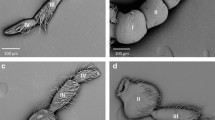Abstract
The sensory receptors of the flagellum ofApis florea were studied with simple and transmission electron microscopy. The antenna consists of scape, pedicel and 10 segmented flagellum. Scape and pedicel have only feather like hairs and no structures like the setae or sensillae of the flagellum. The first two segments of the flagellum were covered with setae. The distribution and population of sensilla trichodea, sensilla placodea and sensilla basiconica were determined. Sensilla trichodea were found in maximum numbers and were present on all the flagellar segments. Sensilla placodea and sensilla basiconica were present on 8 distal segments. Transmission electron microscopy studies revealed that the surface of the shaft of sensilla trichodea is serially striated having small permeable points probably indicating pores. The lumen of the sensillum is filled with many dendrites and the dendrites are enclosed in the dendritic sheath.
Similar content being viewed by others
References
Adam A and Delbruck M 1968 Reduction of dimensionality in biological diffusion process;Structural Chemical and Molecular Biology (eds) A Rich and N Davidson (San Francisco, London: Freeman Co.) p 215
Argen L 1975 Comparison between air drying and critical point drying for SEM studies of the antennae ofApis mellifera L. (Hymenoptera: Apidae);Zoon 3 155–158
Argen L 1977 Flagellar sensilla of some colletidae (Hymenoptera: Apoidea);Int. J. Insect Morphol. Embryol. 6 137–146
Callahan P S 1975 Insect antennae with reference to the mechanism of scent detection and evolution of sensillae;Int. J. Insect Morphol. Embryol. 4 381–430
Dietz A, Anderson L M and Sanford M T 1974 Fractographic studies of the honey bee sensilla coeloconica, sensilla ampullacea and sensilla campaniformia by SEM; in32nd Ann. Proc. electron microscopy Soc. Am. (ed) C J Arsceneaux (St. Lousie, Missouri: Electron microscopy society of America) pp 2
Dietz A and Humphreys W J 1971 Scanning electron microscopic studies of antennal receptors of the worker honeybee, including sensilla campaniformia;Annu. Entomol. Soc. Am. 64 919–925
Ernst K D 1969 Die Feinstruktur Von Riechsensillen auf der Antenne des Aaskafers Necrophorus (Coleoptera);Z. Zellforsch Mikrosk. Anat. 94 72–102
Gupta M 1982Olfactory physiology of Apis florea F. with reference to repellents, Ph.D. thesis, Haryana Agricultural University, Hisar
Harbach R E and Larsen J R 1976 Ultrastructure of sensilla on the distal antennal segment of adultOncopeltus fasciatus (Dallas) (Hemiptera: Lygaeidae);Int. J. Insect Morphol. Embryol. 5 23–33
Hodgson E S 1968 Taste receptors of Arthropods in invertebrate receptors;Symp. Zool. Soc. London No. 23, pp 269–277
Kafka W A 1970 Analyse der mole kularen be der erregung einzelner ricchzellen (Electro-physiologie) einzelner rezdoorzellen auf der antenne vonLocusta migratoria;Z. Vgl. Physiol. 70 105–143
Kaissling K E 1971 Insect olfaction; inOlfaction; (ed) L M Beidler (Berlin Heidelberg New York: Springer Verlag) pp 351–431
Kessel R G and Shih C V 1974Scanning electron microscopy in biology (A studient's atlas on Biological Organization); (Berlin: Springer Verlag)
Krause B 1960 Electrone mikroskopische uniter Suchungen an den plattensensillen des insektenfunless;Zool. Beitr. 6 161–205
Lacher V 1964 Electrophysiologische untersuchungen an einzelnen razeptoren fur geruch, kohlendioxyd, Luft feuchtigkeit and temperature auf den antennen der arbertsluene und der dronne (Apis mellifica L.);Z. Vgl. Physiol. 48 274–278
Lindauer M 1956 Communication among the honey bees and stingless bees of India;Bee World 38 3–14, 34–38
Luft J H 1961 Improvement in embedding methods;J. Biophys. Biochem. Cytol. 9 409
Reynolds E S 1963 The use of lead citrate at high pH as an electron opaque stain in electron microscopy;J. Cell Biol. 17 208–212
Richards A G 1952 Studies on arthropod cuticle viii. The antennal cuticle of honeybees with particular reference to sense plates;Biol. Bull. 103 201–225
Slifer E H 1967 Thin walled olfactory sense on insect antennae.In Insects and physiology, (ed) J W Beatment and J E Treherne (Edinburgh, London: Oliver & Boyd) pp 232–245
Slifer E H and Sekhon S S 1961 The fine structure of the plate organs in the antennal flagellum of the honeybeeApis mellifera L.;J. Morphol. 109 351–381
Steinbrecht R A 1969 Comparative morphology of olfactory receptors III; inInternational Symposium Olfaction and taste; (ed) C Pfattmann (New York: Rockefeller University press) pp 3–21
Vareschi F 1971 Duftunger scheidung bei der hongoiene-Einzel Zellableit ungen und verhaltens reakton;Z. Vgl. Physiol. 75 143–181
Vogel R 1923 Zur kenntnis des feineren baues der geruch-sorgane der waspen und biehen,Z. Wiss Zool. 120 281–324
Whitehead A T and Larsen J R 1976 Ultrastructure of contact chemoreceptors ofA mellifera L. (Hymenoptera: Apidae);Int. J. Insect Morphol. Embryol. 5 301–315
Zacharuck R Y 1980 Ultrastructure and function of insect chemosensilla;Annu. Rev. Entomol. 25 27–47
Author information
Authors and Affiliations
Rights and permissions
About this article
Cite this article
Gupta, M. A quantitative study and ultrastructure of flagellar sensillae ofApis florea F. (Hymenoptera: Apidae). Proc. Indian Acad. Sci. (Anim. Sci.) 95, 595–603 (1986). https://doi.org/10.1007/BF03179423
Received:
Revised:
Issue Date:
DOI: https://doi.org/10.1007/BF03179423




